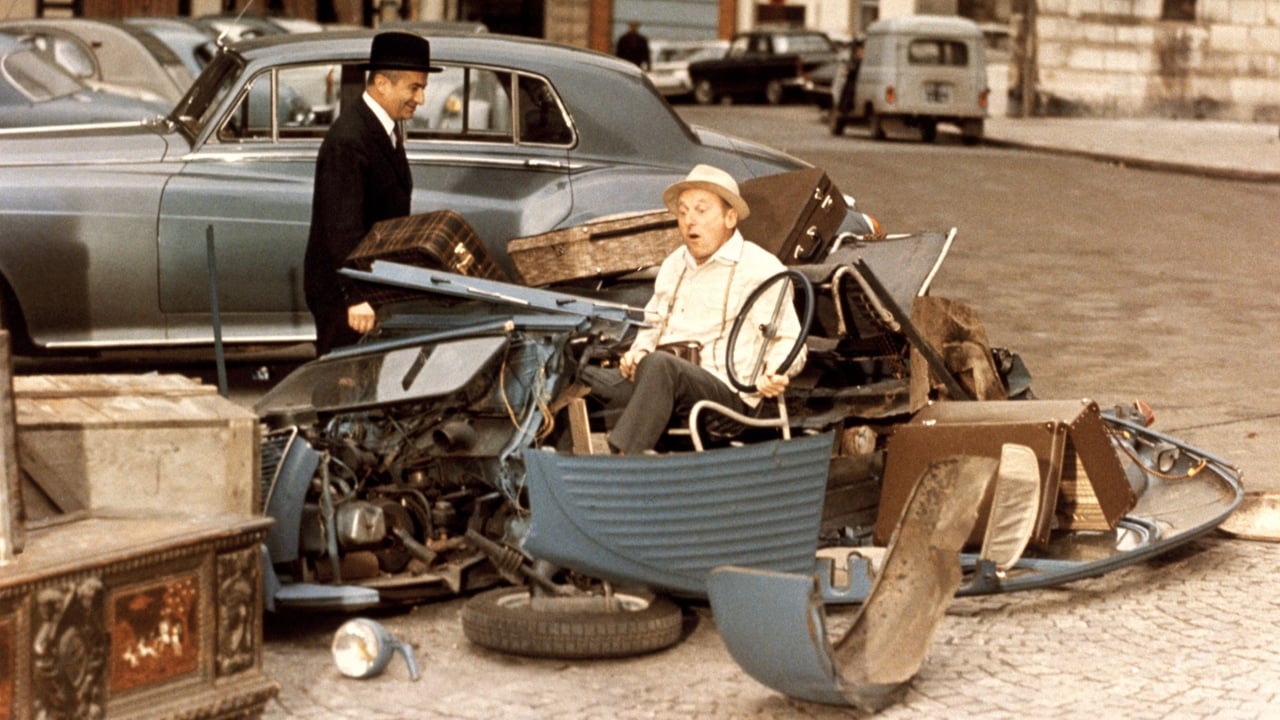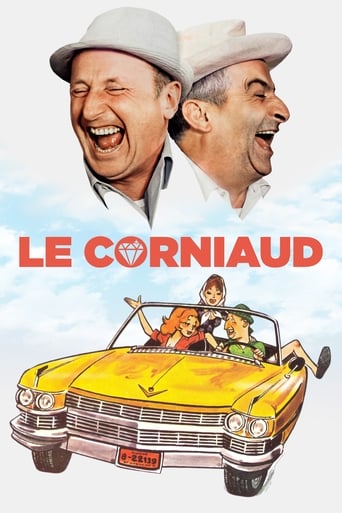

Very best movie i ever watch
... View MoreToo much of everything
... View MoreIt is a performances centric movie
... View MoreThere are moments that feel comical, some horrific, and some downright inspiring but the tonal shifts hardly matter as the end results come to a film that's perfect for this time.
... View MoreIn 1965, French comedy was lead by a triumvirate of actors: the "Big Boss", Fernandel, whose Mediterranean accent resonated in every syllabus like a musical tempo, and whose large mouth served as a decoy to the most iconic and heartwarming smile on the big screen. Then there was the legitimate son: Bourvil, the provincial guy, the lovable and goofy idiot who, just like Victor Hugo who wanted to be "Chateaubriand or nothing", wanted to be the next Fernandel. And then came the third one, the turbulent intruder named Louis De Funès, who popularized the figure of the authoritative yet sneaky boss, any powerful figure with Napoleonic complex.De Funès was no newbie actually, he had twenty years to warm up in supporting roles but 1964 marked his spectacular entrance as the leader of the French box-office with no less than two major successes: "The Gendarm of St Tropez" and "Fantomas". He would never desert the box- office top five until his death in 1983. De Funès had also previously worked with Bourvil, he was the hot- tempered butcher in "The Crossing of Paris" and no one can forget the cave scene where he almost stole the thunder of Gabin and Bourvil. There was just something in this human Donald Duck that magnificently completed the gentle goofiness of Bourvil, like Laurel and Hardy and George and Lenny. Gérard Oury felt the potential and wrote a story where the two comical schools would finally interact.But sometimes they can collide and have regrettable side effects. Bourvil had just finished a movie he made with his all-time idol Fernandel in 1963, it was the first and the last. Bourvil was disappointed by the prima donna attitude of Fernandel during the shooting and swore they would never work together. Fernandel probably felt guilty about it as he delivered one of the most poignant eulogies to Bourvil in 1970. But things were different with De Funès, as he was still a lesser shining star than Bourvil. There was mutual respect between the two men and their only differences were in the acting methods, De Funès needed rehearsals and Bourvil was a natural. But apart from that, the chemistry worked and "The Sucker", released in 1965, proved Oury's intuition right as De Funès and Bourvil are still regarded as the most iconic pairing of French cinema, represented by that unforgettable concluding scene where they both laugh together. The film attracted 11 millions of viewers, which is a remarkable box office gross, even by today's standards. It is still by the way in the Top 20.And as soon as the movie starts, there's a joyous accordion and violin melody playing while we admire the Parisian landscape, the score exudes the optimism of what they call now the "Glorious Thirties", this blessed era of prosperity from the war aftermath to the early 70's. And to add to this little joy in the air, it's summertime and good old Antoine Maréchal (Bourvil) embarks on his 2CV, the ultimate popular car, to go South. And then there's one of the most famous accidents of French cinema, where the Bentley of Leopold Saroyan hits the poor 2CV, which is instantly dislocated like in a Tex Avery cartoon. It isn't much the accident than Bourvil's reaction that makes the scene: he's still holding his wheel and shouts "now, it won't work as well, that's for sure", an improvised line that took De Funès off-guard and you can see him hiding his face to cover a nervous laugh. This scene marks the first direct interaction between two actors, two worlds: the snobbish bourgeois and the popular sucker.But this accidental encounter gives Saroyan an idea, as a syndicate of crime member, he decides to use Augustin as a decoy to a sinister plan consisting on taking a Cadillac from Naples to Paris, in this car, gold, heroine, jewels -including the most precious in the world- are hidden. So, in order to avoid the police, who better than an inoffensive schmuck who looks like Antoine to drive the car without danger? Saroyan promises to track Antoine in the process, unbeknownst to him, a gang of Italian gangsters are also on his tail. And this is how the crazy road movie, with the Italian and French seaside in the backdrop, starts. But if the story gives enough material for both actors to show their comical talents, it is really De Funès who steals the show with two incredible scenes, one where he's imitating his personal idol Charlie Chaplin using a Rossini opera and garage props like the Jewish Barber his scissors during Brahms' Hungarian Dance and another in the shower where he confronts a huge bodybuilder with the most sensual (and ambiguous) smile. This is just classic De Funès. As for Bourvil, he's never as funny as when he interacts with his companion, but the film makes a right choice by not making him a sucker all the time, and in a move that reminded me of the conclusion of "Dinner of Schmucks", the sucker is the one who leads the show, and gets it to the delightful conclusion where the two men have the last laugh together.The film's success was a surprise to everyone, and convinced Oury to make a second film with Bourvil and De Funès, this one would be the highest-grossing French movie of all time: "La Grande Vadrouille" and this time, the two men will act together, because this might be the one reproach we can address to "The Sucker", there are not many scenes with De Funès and Bourvil. But there was enough for De Funès to take the reins of French cinema and consolidates his status after the untimely passing of Bourvil and Fernandel in the early 70's. "The Sucker" can be seen as the historical transition toward the De Funès era, a torch passing moment between two comedic giants. And it beautifully shows in the poster.
... View MoreThis new team-up of Bourvil and Fufu have the same recipe that "La Grande Vadrouille". Bourvil is a kind, simple mind whereas Fufu is a Machiavellian crook. However, Bourvil always bores me while Fufu is a delight: he may be nervous but i can feel behind a great humanity and i really like his beat.Here, they are filmed in Italy in the sixties and it's cool to see how it was like 50 years ago. Personally, i found this movie funnier than the one mentioned above but it lacks its dramatic background as well. The idea of someone who is spied who is spied is original and I don't think it has been used often. Maybe the great surprise of this movie should be its score because Delerue finds a lot of very great themes!
... View MoreOutstanding location shooting in two of Europe's most photogenic countries (Italy and France), a comic 'caper' plot with guns that don't really kill plus two of the greatest comedians in French cinema - Louis de Funes and Bourvil - has to be an unbeatable parlay and in fact the following year they did it again - or something very, very similar in Le Grande Vadrouille in which the director of both films, ex-actor Gerard Oury, brought his daughter, Danielle Thompson, on board as co-scriptwriter. It was also a nice touch to name the Louis de Funes character after the Armenian-American writer William Saroyan, now largely forgotten but once hugely popular whose schtick was humorous whimsey. The plot won't really stand scrutiny under a harsh light; Bourvil's 2CV is totally written off by the roller of de Funes even before he has left Paris on his proposed driving holiday in Italy. Knowing a rube when he sees one de Funes makes Bourvil an offer he can't refuse; the 'loan' of a Cadillac which needs to be driven from Naples to Bordeaux plus a ticket to Naples and spending money. What Bourvil doesn't know, of course, is that the car is bristling with gold, heroin and diamonds and how unwittingly he gets rid of these en route is half the fun. Perhaps a tad dated forty years on but still one of the best 'feelgoods' around.
... View MoreBourvil plays the role of Antoine Marechal, a seemingly witless insurance salesman, who on his way to a vacation in Italy in his "deux cheveaux" automobile gets hit and has his car literally destroyed by the Rolls Royce of Leopold Saroyan, an affluent industrialist played by Louis de Funes. In order to make amends, Saroyan offers to have Marechal complete his trip to Italy in his convertible Cadillac (replete with a mobile phone and phonograph player - this is no less than twenty years before the advent of cellular phones and CD players). What Marechal doesn't know is that the Cadillac is also laden with stolen jewelry and drugs to be smuggled unwittingly by him across the border. What's more, Saroyan and two cronies as well as a smattering of other criminals tail Marechal during his journey across Italy and try to intercept or recharge, as the case may be, the merchandise on board the Cadillac. The hi-jinks in this movie are incredibly funny. This film is a worthy precursor to de Funes' "The Adventures of Rabbi Jacob."
... View More